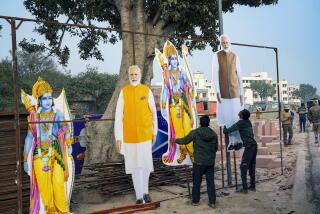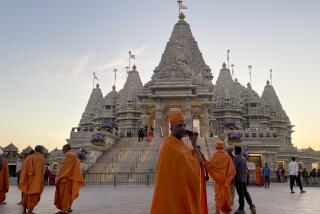Skilled Craftsmen Bring Precious Peace of Mind by Creating a Bit of India in Ohio
- Share via
BEAVERCREEK, Ohio — With each delicate casting, each intricate carving, the three men working on scaffolding outside a building in this Dayton suburb are creating peace of mind.
They are Hindu craftsmen, called silpis , who are completing a 2-year-old dream of transforming the squat concrete temple into a bit of India transplanted next to a cornfield.
The process is called “Indianization,” an important milestone for the Indian community here that dedicated the temple in 1985 but did not have money to complete the work.
“When you have the Indianization, you really get the feeling of a temple, because a temple is so different--reverence--you just feel like God is there,” said Janaki Venkayya, a devotee and spokeswoman for the Hindu Community Organization Inc.
“We call it bahakti , you feel more of the gods’ presence. That’s why we come here, to have peace of mind.”
Heavenly Reward
The 3,000-year tradition of Hinduism teaches that building a temple is worthy of heavenly reward.
A. L. Sathaiah is one of three craftsmen from Madras state in India working on the three gopurams , or intricate domes, topping marble-lined alcoves that house statues of the deities believed to live in the temple.
A fourth gopuram is between the doors of the front entrance.
“We are trained generation to generation. There are no schools,” Sathaiah said. “It’s very difficult work.”
Sathaiah, his son-in-law, S. Ravichandran, and a friend, A. Chidambram, start with a frame of bricks or concrete blocks. Sathaiah said he likes this country’s blocks because they let him build the framework faster than the smaller bricks used in India.
Working from memory, the craftsmen make intricate sculptures by hand from concrete for the ornamentation. They press those into sand to make molds from which concrete or mortar duplicates can be made.
Mortar also is applied to round the gopuram , and delicate designs are carved directly into the outer layer.
“The people here are not familiar with this art of architecture. They can maybe make the molds, but they don’t know enough from memory,” Venkayya said. “We advertised, but they said it is too intricate, too difficult.”
Sathaiah, 44, has practiced his trade in India since he was 22. He has worked on one other temple in this country, in Flint, Mich. He hopes that word of mouth will bring more work as other temples are built around the country.
Live With Priest
Indianization will cost about $100,000, Venkayya said. The workers are paid $12.87 per hour and housed at the nearby priest’s house, she said.
The center gopuram , 32 feet high, will have three tiers of ornamentation. The others, 27 feet high, will have two tiers.
If the temple can raise another $100,000, it will build a free-standing gopuram in front, a traditional temple feature.
“In the olden days they wanted the temple much higher above the houses because only people live in houses and this is God’s house,” Venkayya said.
The gopurams are shrouded in plastic now, protected from the weather that Sathaiah said can begin to make the mortar crack in three years. In India, similar work might last 20 years before needing repair, he said.
During the winter lull, the craftsmen will repair gopurams at a Pittsburgh temple.
They will return to Beavercreek to sculpt 16 figurines of the gods for inside walls and a mural-like sculpture in the basement depicting Krishna in his chariot.
Krishna is an incarnation of Lord Vishnu, the centerpiece of the temple.
More to Read
Sign up for Essential California
The most important California stories and recommendations in your inbox every morning.
You may occasionally receive promotional content from the Los Angeles Times.










